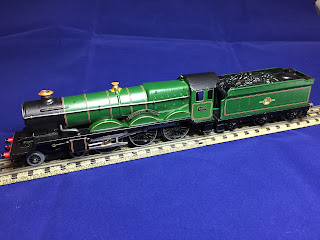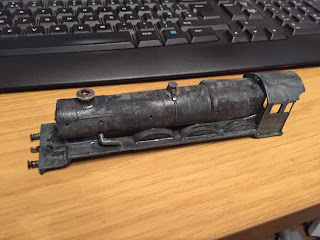Finished work on the tender:
With the bodywork complete, time to look at the chassis.
I hadn't even tested it to see if it would run, just stripped it, cleaned up the armature (nice shiny commutator below) and light oiling where needed.
As this is a City of London chassis, it's of course two rail. I could refit the two rail pickup assembly and fit it underneath the third rail collector, however I still had the remains of another scrap two rail City of London chassis so decided to remove the wheels and replaced the insulated ones on this chassis to give current return through all wheels.
Having refitted the wheels and third rail collector (using some recently refurbished spoons!) the chassis was reassembled for testing. After a few stutters it was running as expected with current draw around 1/4 amp.
Last few jobs, straighten and clean up the handrails:
And then, after stripping the smoke deflectors back to bare metal, these were repainted and refitted to the body to complete the restoration.
Time for a test run around the loft, which went as expected.
Sadly however I dropped the loco shortly before taking the glamour shot below, damaging part of the cab side lining, which is highly annoying and can just about be seen in the picture below. For now it can wait, the loco runs on the inner loop so this side faces inwards! I'll get around to repairing it eventually.
So this is the City of Liverpool completed. Still not happy with the yellow lining but it's as good as I can get it with my limited artistic skills.
With work on this City completed, I can now begin planning the restoration of the other City body...



















































